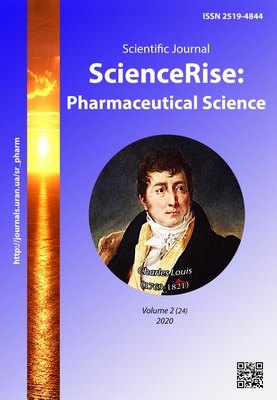Primary selection of the prebiotic components in the complex dermatological therapeutic and preventive medicine with probiotic
DOI:
https://doi.org/10.15587/2519-4852.2020.201104Keywords:
lactobacilli, probiotics, prebiotics, skin microbiome, dermatological diseases, therapeutic and preventive medicineAbstract
The aim. Selection of optimal prebiotic components for bacteria of the genus Lactobacillus for their joint use in a complex dermatological therapeutic and preventive medicine with a probiotic.
Methods. Co-cultivation of a probiotic strain in a liquid MRS nutrient medium with an active ingredient at selected concentrations. During the cultivation cycle, samples of growing culture were selected at specific intervals to determine bacterial concentration by direct seeding and acidity determination.
Results. During 48 h of co-cultivation of lactobacilli with selected components, were observed a significant increase of viable cells, both in control and with the addition of vitamins at selected concentrations (exponential bacterial growth phase), from 48 h to 60 h - decrease of the rate of cell growth as in control group, and in experiments, the number of cells remains almost constant (stationary phase of bacterial growth), after 60 h - decrease of the number of cells (phase of dying).
During cultivation, the oxidation of the nutrient medium resulting from the formation of lactic acid carbohydrates and other terminal metabolites were observed; that is, the addition of components slightly increases the biochemical potential of microorganisms, as evidenced by the increase in biomass and acid potential.
Although there was no significant difference between one series of experiments with different vitamin contents, the largest increase in viable cell was observed with vitamin B5 (concentration 1 %) and provitamin B5 (concentration 2.5 %).
Conclusions. Optimal prebiotic components for use with lactobacilli as part of dosage form were selected. Despite the pronounced synergism of action of the vitamin B5 and D-panthenol, all other components are also promising due to the positive effects on human skin and lack of negative effects on lactobacilli
References
- Stepanenko, V. I. (Ed.) (2012). Dermatologiya i venerologiya. Kyiv: КІМ, 848.
- Turnbaugh, P. J., Ley, R. E., Hamady, M., Fraser-Liggett, C. M., Knight, R., Gordon, J. I. (2007). The Human Microbiome Project. Nature, 449 (7164), 804–810. doi: http://doi.org/10.1038/nature06244
- Araviiskaia, E. P., Sokolovskii, E. V. (2016). Microbiome: a new era in normal and pathological changes skin studies. Vestnik dermatologii i venerologii, 3, 102–109.
- Grice, E. A., Kong, H. H., Conlan, S., Deming, C. B., Davis, J. et. al. (2009). Topographical and Temporal Diversity of the Human Skin Microbiome. Science, 324 (5931), 1190–1192. doi: http://doi.org/10.1126/science.1171700
- Cogen, A. L., Nizet, V., Gallo, R. L. (2008). Skin microbiota: a source of disease or defence? British Journal of Dermatology, 158 (3), 442–455. doi: http://doi.org/10.1111/j.1365-2133.2008.08437.x
- Structure, function and diversity of the healthy human microbiome (2012). Nature, 486 (7402), 207–214. doi: http://doi.org/10.1038/nature11234
- Yatsunenko, T., Rey, F. E., Manary, M. J., Trehan, I., Dominguez-Bello, M. G., Contreras, M. et. al. (2012). Human gut microbiome viewed across age and geography. Nature, 486 (7402), 222–227. doi: http://doi.org/10.1038/nature11053
- Nakatsuji, T., Chiang, H.-I., Jiang, S. B., Nagarajan, H., Zengler, K., Gallo, R. L. (2013). The microbiome extends to subepidermal compartments of normal skin. Nature Communications, 4 (1). doi: http://doi.org/10.1038/ncomms2441
- Muizzuddin, N., Maher, W., Sullivan, M. (2012). Physiological effect of a probiotic on skin. Cosmet Sci, 63, 385–395.
- Chicherin, I. Y., Pogorelskiy, I. P., Lundovskikh, I. A., Мalov, A. A., Shabalina, M. R., Darmov, I. V. (2013). Dynamics of the Content of Lactobacilli, Microbial Metabolites and Antimicrobial Activity of Growing Culture of Lactobacillus Plantarum 8P-A3. Journal Infectology, 5 (3), 50–55.
- Yarullina, D. R., Fahrullin, R. F. (2014). Bakterii roda Lactobacillus: obshaya harakteristika i metody raboty s nimi. Kazan: Kazanskii universitet, 51.
- Mesquita, A. R. C. de, Silveira, L. P. da M., Cruz Filho, I. J. D., Lima, V. F. de, Silveira Filho, V. D. M., Araujo, A. A. et. al. (2017). Metabolism and physiology of Lactobacilli: a review. Journal of Environmental Analysis and Progress, 2 (2), 125–136. doi: http://doi.org/10.24221/jeap.2.2.2017.1202.115-124
- Bespomestnyh, K. V. (2014). Izuchenie vliyaniya sostava pitatelnoj sredy na izmenenie biohimicheskih i morfologicheskih svoistv shtammov laktobacill. Sovremennye problemy nauki i obrazovaniya, 6. Available at: https://www.science-education.ru/ru/article/view?id=16600
- Kaliuzhnaia, O. S., Strelnikov, L. S., Strilets, O. P., Kabachniy, G. I. (2009). Rozrobka skladu i tehnologiyi supozitoriyiv dlya profilaktiki ta likuvannya vaginalnih disbioziv. Zaporozhskii medytsynskyi zhurnal, 11 (3), 86–89.
- Fadeeva, I. V. (2004). Razrabotka kompleksnogo probioticheskogo preparata na osnove laktobakterii. Perm, 24.
- Akulevich, O. V., Oryabіnska, L. B., Dugan, O. M. (2013). Kinetika rostu molochnokislih bakterii rodu Lactobacillus na zhivilnih seredovishah z riznomanitnimi dzerelami vuglecevogo I azotnogo. Naukovі vіstі NTUU «KPІ», 3, 7–11.
- Hizhnyak, O. S. (2016). Rozrobka skaldu ta biotechnologii otrimannya komplesnogo probiotichnogo preparatu. Kharkiv, 204.
Downloads
Published
How to Cite
Issue
Section
License
Copyright (c) 2020 Alina Soloviova, Olha Kaliuzhnaia, Leonid Strelnikov

This work is licensed under a Creative Commons Attribution 4.0 International License.
Our journal abides by the Creative Commons CC BY copyright rights and permissions for open access journals.








